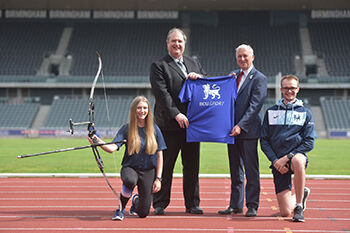University News Last updated 30 August 2019

Plans unveiled today announced that Birmingham’s redeveloped Alexander Stadium will provide a new base for up to a thousand Birmingham City University sports and exercise students, leaving a major sporting legacy in the city.
The agreement will see the Stadium, currently going through the planning application process ahead of a proposed £72 million transformation for the Birmingham 2022 Commonwealth Games, provide a new home for students - equipped with state-of-the-art facilities.
It complements broader plans to regenerate Perry Barr and north-west Birmingham, which will include up to 5,000 homes, of which c.2,000 will be delivered on the site initially being used for the Commonwealth Games Village. In addition there will be a range of public realm and infrastructure improvements including a redeveloped public transport interchange, Sprint bus rapid transit services and enhanced options for cycling and walking.
Birmingham City University and Birmingham City Council bosses met today (Friday 30 August) to put pen to paper on the deal – which means Birmingham City University will become one of the venue’s ‘anchor tenants’, and ensure the Stadium remains an important part of the sporting fabric of the city, region and nation for years to come.
Set over three storeys in a newly-redeveloped Western Stand, the agreement will allow the University to expand its offering by providing provision to accommodate up to 1,000 students.
The University originally launched its sports and exercise courses in 2016, with the studies, which include Sports Nutrition, Physiotherapy and Biomedical Science, proving hugely popular with students preparing for careers in the sporting industries.
And thanks to the deal, hundreds of staff and students are now set to move to the venue following the conclusion of the Birmingham 2022 Commonwealth Games.
The site will be furnished to include state-of-the-art sporting equipment such as environmental chambers and anti-gravity treadmills, providing elite level training for students.
The deal will play a key role in creating a sporting legacy in the city beyond the conclusion of the Games, and create a new generation of sports professionals including physiotherapists, sports scientists, nutritionists and teachers.
It also allows Birmingham City University to cement its history in the Perry Barr area, which dates back to the opening of North Birmingham Technical College in 1966, later incorporated into Birmingham Polytechnic in 1971.
Professor Philip Plowden, Vice-Chancellor at Birmingham City University said: “The sport programmes at Birmingham City University are some of our fastest-growing, and we are delighted that we will be making world-class facilities available for our students.
“Alexander Stadium is an iconic part of Birmingham’s sporting offering, which will take centre stage in the coming years, and it will make a fitting home for our sporting staff and students. It is also very pleasing that we are maintaining our strong links with Perry Barr, which, for so long was our main site.
The council formally unveiled plans for the redevelopment of the Stadium in June to kick off a public consultation into the plans. A full planning application is due for submission shortly, with construction work then starting in early 2020, subject to approval being granted.
Cllr Ian Ward, Leader of Birmingham City Council, said: “For decades, the Alexander Stadium has had a deserved reputation as a first-class athletics venue, but we have never fully realised the potential of the site.
“The investment now being made into this venue and Perry Barr more broadly is in excess of £0.5billion, so it is crucial we create an enduring legacy beyond the summer of 2022.
“This exciting new partnership with BCU brings a new and meaningful purpose for the stadium. We need it to operate 365 days a year, rather than on limited number of occasions it currently does. This deal lays the foundations for further investment to make the revamped Stadium the focal point for community, leisure, sport, health and well-being activity in a regenerated Perry Barr.”